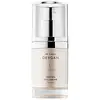What's inside
What's inside
 Key Ingredients
Key Ingredients

 Benefits
Benefits

 Concerns
Concerns

 Ingredients Side-by-side
Ingredients Side-by-side

Water
Skin ConditioningTetrahexyldecyl Ascorbate
AntioxidantCaprylic/Capric Triglyceride
MaskingSodium PCA
HumectantSqualane
Emollient3-O-Ethyl Ascorbic Acid
Skin ConditioningAscorbic Acid
AntioxidantLactic Acid
BufferingCentella Asiatica Extract
CleansingSodium Hyaluronate
HumectantCeramide Ng
Skin ConditioningSuperoxide Dismutase
AntioxidantUbiquinone
AntioxidantPhyllanthus Emblica Fruit Extract
HumectantSaccharide Isomerate
HumectantGlycyrrhiza Glabra Root Extract
BleachingEctoin
Skin ConditioningNiacinamide
SmoothingSoy Isoflavones
Skin ConditioningQuercetin
AntioxidantPhospholipids
Skin ConditioningCaffeine
Skin ConditioningTranexamic Acid
AstringentFerulic Acid
AntimicrobialCarnitine
CleansingAdenosine
Skin ConditioningZinc PCA
HumectantGlycerin
HumectantButylene Glycol
HumectantCaprylyl Glycol
EmollientCaesalpinia Spinosa Gum
Skin ConditioningHectorite
AbsorbentSilica
AbrasiveHdi/Trimethylol Hexyllactone Crosspolymer
Leuconostoc/Radish Root Ferment Filtrate
AntimicrobialPolyacrylate Crosspolymer-6
Emulsion StabilisingCetearyl Olivate
Carbomer
Emulsion StabilisingPotassium Hydroxide
BufferingSorbitan Olivate
EmulsifyingCitric Acid
BufferingPentasodium Pentetate
Potassium Citrate
BufferingPotassium Gluconate
Skin ProtectingPhytic Acid
Phenoxyethanol
PreservativeSorbic Acid
PreservativePotassium Sorbate
PreservativeCI 77891
Cosmetic ColorantWater, Tetrahexyldecyl Ascorbate, Caprylic/Capric Triglyceride, Sodium PCA, Squalane, 3-O-Ethyl Ascorbic Acid, Ascorbic Acid, Lactic Acid, Centella Asiatica Extract, Sodium Hyaluronate, Ceramide Ng, Superoxide Dismutase, Ubiquinone, Phyllanthus Emblica Fruit Extract, Saccharide Isomerate, Glycyrrhiza Glabra Root Extract, Ectoin, Niacinamide, Soy Isoflavones, Quercetin, Phospholipids, Caffeine, Tranexamic Acid, Ferulic Acid, Carnitine, Adenosine, Zinc PCA, Glycerin, Butylene Glycol, Caprylyl Glycol, Caesalpinia Spinosa Gum, Hectorite, Silica, Hdi/Trimethylol Hexyllactone Crosspolymer, Leuconostoc/Radish Root Ferment Filtrate, Polyacrylate Crosspolymer-6, Cetearyl Olivate, Carbomer, Potassium Hydroxide, Sorbitan Olivate, Citric Acid, Pentasodium Pentetate, Potassium Citrate, Potassium Gluconate, Phytic Acid, Phenoxyethanol, Sorbic Acid, Potassium Sorbate, CI 77891
Water
Skin ConditioningHelianthus Annuus Seed Oil
EmollientGlycerin
HumectantDimethicone
EmollientIsopropyl Palmitate
EmollientPalmitoyl Tripeptide-1
Skin ConditioningPalmitoyl Tetrapeptide-7
Skin ConditioningSteareth-20
CleansingChrysin
Skin ConditioningN-Hydroxysuccinimide
Skin ConditioningButylene Glycol
HumectantCarbomer
Emulsion StabilisingPolysorbate 20
EmulsifyingGlycol Distearate
EmollientGlyceryl Stearate
EmollientPEG-100 Stearate
Stearic Acid
CleansingStearyl Alcohol
EmollientPhytonadione Epoxide
AstringentVitis Vinifera Seed Oil
EmollientPersea Gratissima Oil
Skin ConditioningTocopheryl Acetate
AntioxidantAllantoin
Skin ConditioningTitanium Dioxide
Cosmetic ColorantTetrasodium EDTA
Triethanolamine
BufferingPhenoxyethanol
PreservativeEthylhexylglycerin
Skin ConditioningWater, Helianthus Annuus Seed Oil, Glycerin, Dimethicone, Isopropyl Palmitate, Palmitoyl Tripeptide-1, Palmitoyl Tetrapeptide-7, Steareth-20, Chrysin, N-Hydroxysuccinimide, Butylene Glycol, Carbomer, Polysorbate 20, Glycol Distearate, Glyceryl Stearate, PEG-100 Stearate, Stearic Acid, Stearyl Alcohol, Phytonadione Epoxide, Vitis Vinifera Seed Oil, Persea Gratissima Oil, Tocopheryl Acetate, Allantoin, Titanium Dioxide, Tetrasodium EDTA, Triethanolamine, Phenoxyethanol, Ethylhexylglycerin
Ingredients Explained
These ingredients are found in both products.
Ingredients higher up in an ingredient list are typically present in a larger amount.
Butylene Glycol (or BG) is used within cosmetic products for a few different reasons:
Overall, Butylene Glycol is a safe and well-rounded ingredient that works well with other ingredients.
Though this ingredient works well with most skin types, some people with sensitive skin may experience a reaction such as allergic rashes, closed comedones, or itchiness.
Learn more about Butylene GlycolCarbomer is a polymer of acrylic acid. Its main role is to create a gel consistency.
A high amount of carbomer can cause pilling or balling up of products. Don't worry, most products contain 1% or less of carbomer.
Glycerin is already naturally found in your skin. It helps moisturize and protect your skin.
A study from 2016 found glycerin to be more effective as a humectant than AHAs and hyaluronic acid.
As a humectant, it helps the skin stay hydrated by pulling moisture to your skin. The low molecular weight of glycerin allows it to pull moisture into the deeper layers of your skin.
Hydrated skin improves your skin barrier; Your skin barrier helps protect against irritants and bacteria.
Glycerin has also been found to have antimicrobial and antiviral properties. Due to these properties, glycerin is often used in wound and burn treatments.
In cosmetics, glycerin is usually derived from plants such as soybean or palm. However, it can also be sourced from animals, such as tallow or animal fat.
This ingredient is organic, colorless, odorless, and non-toxic.
Glycerin is the name for this ingredient in American English. British English uses Glycerol/Glycerine.
Learn more about GlycerinPhenoxyethanol is a preservative that has germicide, antimicrobial, and aromatic properties. Studies show that phenoxyethanol can prevent microbial growth. By itself, it has a scent that is similar to that of a rose.
It's often used in formulations along with Caprylyl Glycol to preserve the shelf life of products.
Water. It's the most common cosmetic ingredient of all. You'll usually see it at the top of ingredient lists, meaning that it makes up the largest part of the product.
So why is it so popular? Water most often acts as a solvent - this means that it helps dissolve other ingredients into the formulation.
You'll also recognize water as that liquid we all need to stay alive. If you see this, drink a glass of water. Stay hydrated!
Learn more about Water